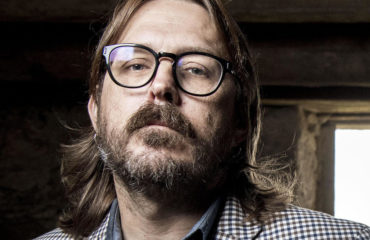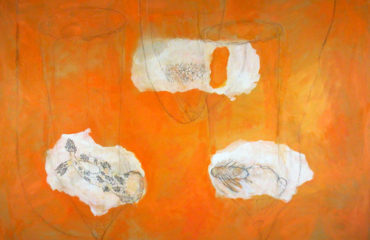Late to the Search Party is the debut collection of Steven Espada Dawson, exploring the individ...

JUNE INTERVIEW WITH STEVEN ESPADA DAWSON

MAY INTERVIEW WITH SOPHIA TERAZAWA
When readers first meet the narrator of Sophia Terazawa’s novel, Tetra Nova, published by Deep ...

FEBRUARY MONTHLY: INTERVIEW with CLAIRE HOPPLE
From the first sentence of Claire Hopple’s latest novel, Take It Personally, you know you’re in...

JANUARY MONTHLY: INTERVIEW WITH MARIA ZOCCOLA
Any reader with even a cursory understanding of Greek mythology will recognize her name: Helen ...

DECEMBER MONTHLY: INTERVIEW WITH JIMIN SEO
Jimin Seo is the author of OSSIA, his debut collection of poetry. Winner of the The Changes Pre...
ON THE PHOTOGRAPH: AN INTERVIEW with Rachel Eliza Griffiths

from FWR Poetry Editor Nathan McClain:
While at Cave Canem, I had the opportunity to chat with, and interview, poet and photographer Rachel Eliza Griffiths on the functionality and nature of photography and, more specifically, how aspects of the gaze and engagement contribute to a photo’s overall work. Her responses were far too wonderful and in-depth to distill, so I’ve provided Rachel Eliza’s responses, in their entirety, for your perusal. Rachel Eliza, too, provided us with a photo essay, which I’ve embedded in her response, as I sense the two are in conversation.
A poem, or a photograph, after it leaves you, is a virus that exists in the world. It replicates itself and, despite its framing, it cannot be contained. My hope is that Rachel Eliza’s photos and responses affect, or maybe more so infect, you…
NM: How would you say the photograph directs the gaze in a way the poem may not?
REG: I want to be careful to not make any sweeping statements, as your questions are so interesting and fluid to me. I’ll think of these questions for years. I admit that I feel the photographer in me resisting my efforts to verbalize or theorize the parts of me where my visual alphabet works in terms of imagination and politics. There is obviously as much nuance within photography and photographers as there is amongst poets and the tools/language they employ to shape, light, and to shadow their work. For me, there are shared spaces between imagery and vocabulary and other spaces where neither can help, witness, direct, or translate the other.
The presence of tension and intuition, whether in a poem or photograph, is critical for me in terms of process. When I think of process, I think of my body and of its systems. How I experience my body, as I am writing, is distinct from the sensations I experience when I’m using my camera. For both, landscape – where I am and with whom and where, the specific geography – becomes literal, internal, spectral, exterior. I don’t resist these contradictions. I get away from squares, unless they are pages or viewfinders. For a while, all shapes are doors, stairs, and windows. After photographing, I feel my work in my muscles, my back, hips, and arms. They’re sore. When I write I have to remember my body. I look up and hours may have passed without me even getting up for a glass of water.
In a photograph, I have to meet myself as an “I” in ways that I’m unable to articulate in a poem. But I don’t see this as a failure. The mood or space where tension exists comes from the same vulnerability, the same power. In a poem the “I” is working at something, so interior, that the photograph can barely perceive it, much less reveal it in its entirety to my own gaze.
For example, many of my self-portraits included here incorporate blurring. If I take an image of myself and I seem too still in it I feel as if I’m dead somehow. I get freaked out. Blurring helps me see how spiritual I am and reminds of how the past, present, and future can function in a two-dimensional portrait of one’s self. I don’t necessarily need narrative but I often like to sense movement in the environment, which is also living and moving.
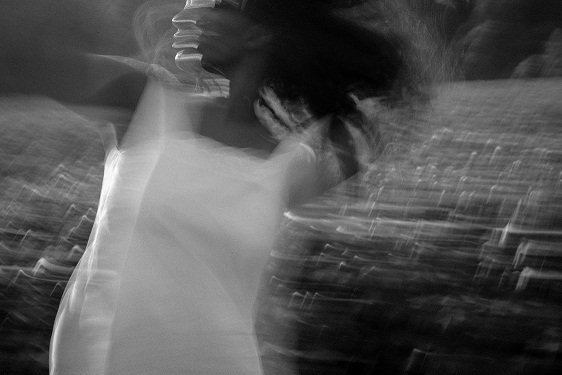
When I’m looking at myself I’m hoping for discovery. I accept the outside and reject the outside. I accept the inside and reject the inside. I use language and I subvert language. Texture, color, light, shadow, frame/composition, sound, absence, voices, and faces become surrogates for what I cannot say. Recently I began to incorporate my body in photographs. That space is difficult to metastasize, or offer in my poems because of how freighted and unstable language can be. I think of alchemy, authority and permission, and how those relate to photographers and to poets. Sometimes I think of the gaze and I think about beauty and desire and violence. I think about how a poem about my body might be received if it were placed next to an image of my body. I try to let the work say it because the work knows it better and more honestly than grammar. People will say a photograph does not lie but, of course, photographs lie too.
But photographs and poems also become glyphs – they’re 2D. I’m not. I have to push at them, break them, to give them bones and flaws and flesh that can outlive me. There is a relationship that must happen immediately, structurally, thematically, and psychologically between the poet and the reader. Mortality happens between the poet and reader. The photograph itself happens immediately and then, if the photograph is strong enough, it will reverberate and live, sometimes hidden for years, inside of the gaze where it was first experienced.
Time in a photograph also splices and freezes an experience in a way that I feel a strong poem can also transform its reader. For example, consider the past and the future. I don’t know if the present tense exists in photographs but it does, often, in poems. When I invoke the past or the future in a poem I don’t see it with the same lifespan a photograph holds. Photographers can photograph or intuit the future but the implication of doing that almost goes against the common intention of most images, which are snapshots, which is to convey what Reality is/was like. With the “likeness” being accurate enough to the real. Being ‘accurate’ in a poem has little value or meaning unless it is part of the poem’s truth. It is easier for us to accept a photograph or dismiss it as, ‘that’s not real’ in a way that does not happen easily in a strong poem. Poems make us believe in ways that photographs aren’t necessarily concerned with – and this calls into light the places where the air thins between these ideas.
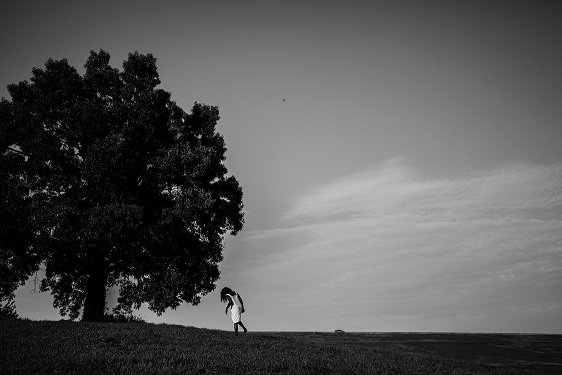
Our world is so visually conscious of itself. While certain types of cropping or manipulation, lack of credit, laws of fair use, etc. in a photograph can be egregious sites of outrage, manipulation in a photograph is usually not as averse to our reaction to feeling manipulated by a poet. Is there more at stake when we, in our roles as “readers”, are manipulated?
Most of the time we assume that the photograph we are seeing has been revised, edited. And a photographer is more likely to have a photograph plagiarized or appropriated (without much consequence) than a poem. Some photographers are okay with this because of how democracy, amongst photography, works in its contemporary republic. Most people would never quote or use a poet’s work without providing some attribution or credit. But photographers expect this and as such, there are photographers who make their living by selling ‘stock’ images. ‘Stock poetry’, wherever it appears, is usually derided. As viewers, we are more likely to be impressed and admire a skilled photographer’s manipulation of an image than we might necessarily be if we were to witness a certain type of cleverness or verbal pyrotechnics in a poet’s toolbox. We might be dismissive of that poet for being ‘experimental’ or ‘too much’ or find such dazzling attempts as distractions from the work itself.
There’s The Gaze too. I don’t have enough space to go into that! But reciprocity is part of this conversation. We must speak of what is private and public within the context of the gaze. What is authorized. What is banned. What is legislated and outlawed. Do we judge the photographer for immorality or ethical trespass in the same way we might apply such concepts to a poem or a poet? When a photographer has the opportunity to ‘take the shot’ (always this hyper-aggressive vocabulary of taking, shooting, capturing), what is at stake? What is at stake for a poet who gives voice to those who cannot speak? What is at stake for a photographer, who looks, makes visible the necessary moment, when the world will not see or would not see otherwise? What is at stake when the poet executes that identical gesture? How do we compare the notion of silence and speech when it occurs in either poem or photograph?
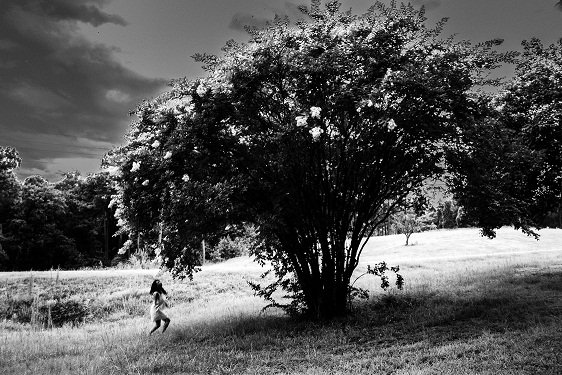
Depending on who is looking, the photographer is as much the object and subject as the production of the final image. For example, consider celebrity photographers whose celebrity will sometimes be noted and lauded before any actual attention is given to the work. I believe that this happens, but a bit differently, with poets. The notion of a photographer as ‘author’ can be as expansive as the poet’s task. But there are other elements to examine for both poet and photographer including accountability, anonymity, privilege, intention, politics, ethics, and of course, imagination. Again, it depends on the type of photographer. War photographers need different tools than underwater photographers or wedding photographers. I don’t have any judgment about this. I believe it’s about the way you feed your eyes, what you must look at and what you need to see and every wound of gray in between.
NM: Is there a way in which we engage with a photo that we do not with a poem?
REG: There are many ways! I think about this all of the time so I don’t have a static answer. We engage poems differently, even amongst ourselves, as readers of poetry. We assign value (and outrage) in dynamic terms when it comes to photography in ways we might not when we are reading. We engage photographs differently when they appear in museums, advertisements, family albums, or social media. Many of us are curating various narratives and lifelines with our ‘smart’ devices. There is also a global coherence that is happening now, irreversibly, because of technology. This is complicated, revolutionary, amazing, and dangerous.
If I read a poem written in English it possesses a distinct fluency because my first language is English. In which language(s) do we experience photographs? Many of my favorite photographers are not American. But how can you look at photograph and immediately discern its author’s identity or where that photographer is from? How does the concept of universality relate to a photograph beyond the image itself and for its own sake?
With poems, it’s interesting. If I’m reading a poem that was originally written in French, I’m likely to look at several translations or ask friends for suggestions for the most informed version. I’ll be looking for the best version, the closest version. I have to do more work because I want to experience the language of the poem as closely to its original text as possible. All translations are not equal but how would that notion manifest in photography?
Intimacy is also something I often think about in relationship to both poetry and photography. The intimacy I might share in a photograph is neither identical nor lateral to the intimacy I share in a poem. Both forms engage different threads of the gaze. These forms are often contradictory in relation to the acceptance or rejection of the gaze. The shapes of the gaze in either medium are relative to my content and intention. For me, any attempt to answer this question only provokes questions. Who is the We? How do we, as individuals and public citizens, understand, maintain, and define ‘literacy’? Personally, I’ve had numerous experiences where there is concerned.
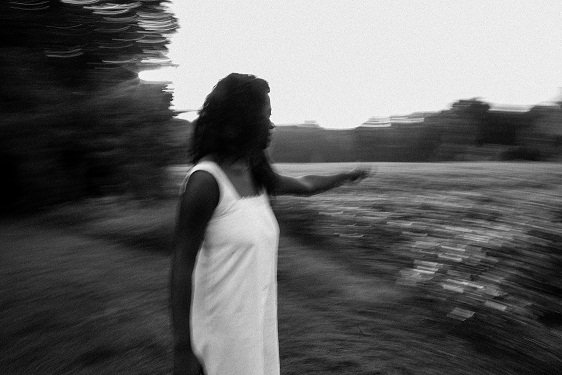
Photography’s functions are not identical to poetry’s processes and forms. Perhaps poetry and photography are fraternal twins. If I look at a photographer’s work my dialogue with that work happens in a matter of seconds. I find an opening, a narrative (however fragmented or fractured), a visual seduction or rhythm, an emotion that is persistent. Visceral. I find what fails in its complete articulation to be verbal or knowable.
